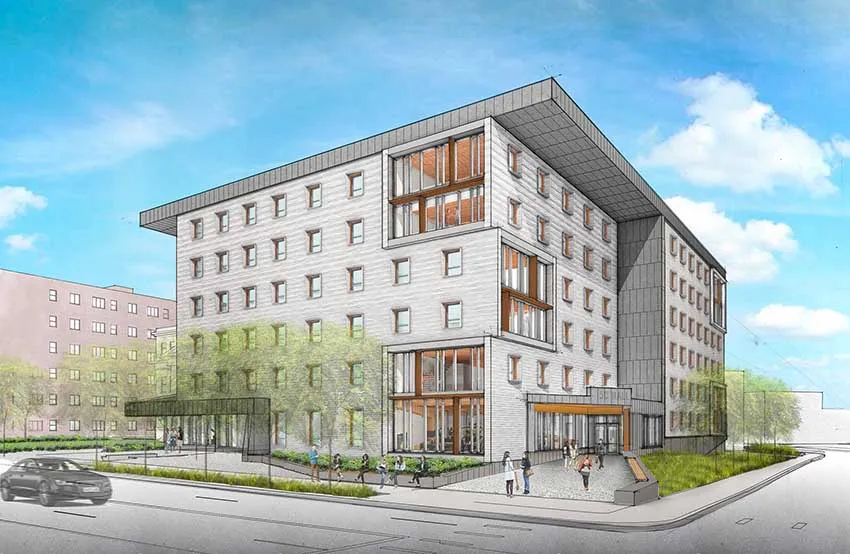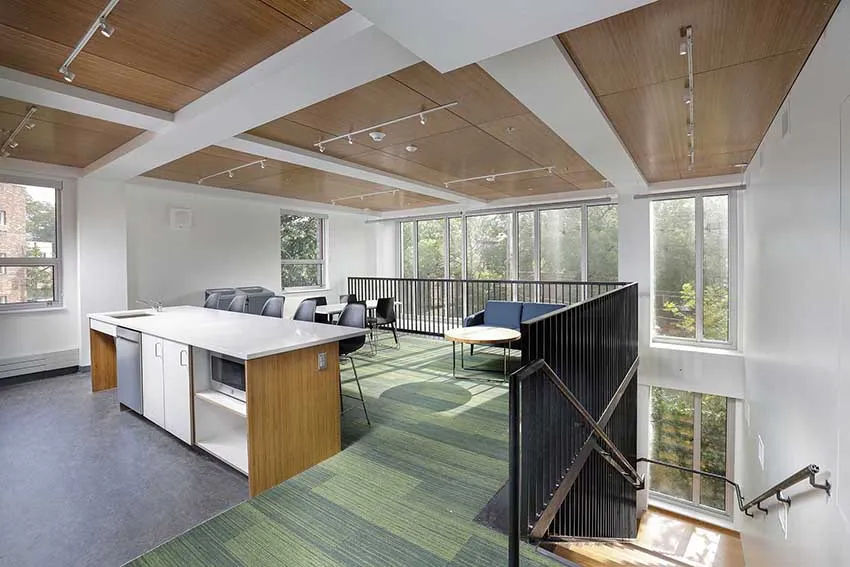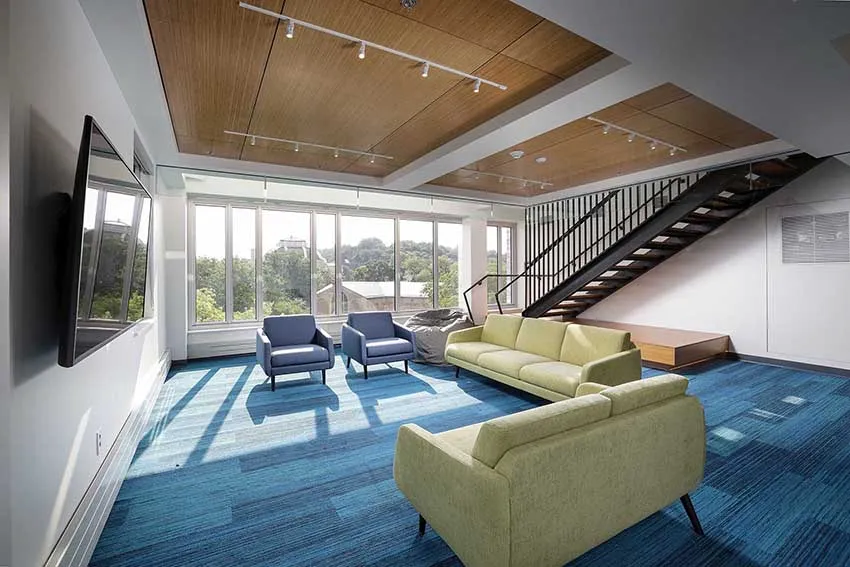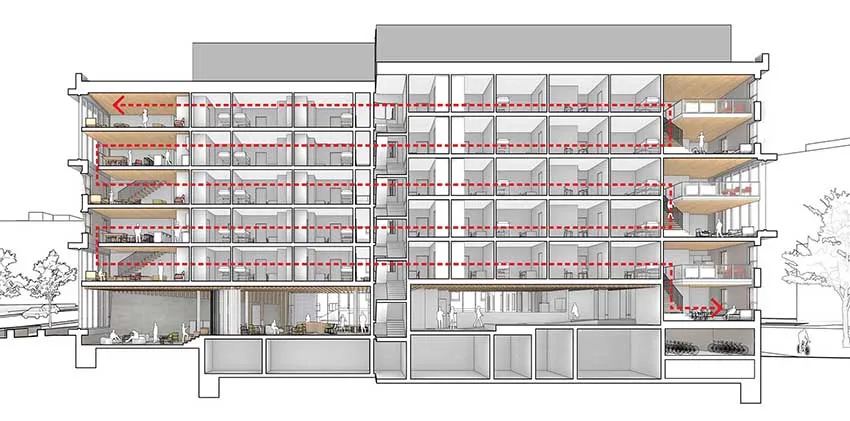Carnegie Mellon University Residence
Pittsburgh, PA | University Residence Hall | Rycon Construction
- Interview Featuring:
- Anna Knoell

This 264-bed residence hall for Carnegie Mellon University is located on a lively thoroughfare just off the school’s campus.
Embracing the urban corner site, the dormitory connects the university community with the surrounding neighborhood through generous plazas and expansive glazing. Inside, double-height common areas give residents a space to study, unwind, share a meal, and expand their social lives outside their dorm rooms. The building also houses Carnegie Mellon’s first “Neighborhood Commons,” part of a planned network of flexible community spaces designed to foster student wellness and encourage interaction.
To learn more about this distinctive dorm, Acelab zoomed in with project managers Anna Knoell from LTL Architects and Jennifer Szczesniak from Perfido Weiskopf Wagstaff + Goettel (PWWG).


Acelab: What special considerations go into the windows for a dormitory?
Anna: Well, we want the building to last 100 years, so durability was key since it is a dorm that will house different students each year. The university is also very concerned with sustainability and energy efficiency.
Like many housing schemes, it's essentially the same plan stacked through the building, so we used the color variation and detailing of the somewhat repetitive windows to really animate the facade and create a street presence. These typical five-feet-by-four-and-a-half-feet punched windows are fairly big for a dorm.
We also enlivened the facade with these double-height spaces on the corners, which are social community rooms. They interlock at the southeast corner in the northeast corners and have these double-height window walls. You can actually move through the whole project linked by the double-height spaces with their expansive windows.


How are the two types of windows detailed differently?
Jennifer: The punched windows are all awning windows but are slightly different on the two sides of the building. On the south side, we used brick surrounds to provide solar shading. The brick fins are asymmetrical and come out to a point. There's more overhang for solar, and then they sort of taper down. Then, on the east building, the fins are more robust, straight up and down to give the students a little bit more privacy. All of the student windows have custom-colored aluminum panning to match the color of the terracotta fins at the double-height spaces.
For the window walls, we designed these with terracotta fins for solar shading on those big expanses. However, these aren't storefronts or curtain walls. It's a wall of unitized windows. They are standard-sized windows that we just put in place, which gave a much better thermal value.
In coordinating these two types of windows, we looked for a manufacturer who could provide a high-quality window as well as a nice profile that can be shared between the two facade treatments across the building. For cost reasons, we had to find a unitized window system that would work not only for the dorm rooms, but also for the larger community spaces. The products used in the two window systems are very similar, actually.

The building’s south facade with just-visible colored panning and brick “fins” shading the punched openings. The multi-toned gray facade combines masonry and high-performance pozzolan made from 100% recycled post-consumer glass. (Image by LTL Architects)


As for the double-height spaces, how did that unitized system work with these custom terra cotta pieces?
Jennifer: Getting the mullions of the windows to line up with the terracotta fins was tricky. Things sort of flip-flop as you go around the building. And of course, you have to make sure there is still a consistent thermal envelope. The aluminum window manufacturer [Wausau Window and Wall Systems] also provided an interior sealant which is really an air sealant to make sure that that air barrier was complete.
Anna: We call them the doughnuts because of their shape, and they became this very detail-intensive spot in the building. They had to be a little special structurally because they had to support the windows, masonry, and the terracotta and have that clean profile without too much sort of structural support showing. The sandwich between that steel, the terracotta, the glazing — it all became sort of a very, very tight coordination area.
Products from this Case Study on Acelab
Windows by: Wausau Window and Wall Systems
Click on Images to see more
Browse AllWhat challenges arose in the specification process?
Jennifer: We really worked with the manufacturer and the contractor to figure out the colored pieces around the punched windows, which are actually custom panning pieces that live within the brick. We ended up putting the panning system in first and then laid the bricks and the sills and the headers around it. It was protected the whole time. We were able to get this really good connection with a panning system.

Building core under construction. (Image by LTL Architects)
Did you make a full-scale mock-up?
Jennifer: We did do a large scale mock-up, which was a big deal, I think. We found that in order for the openers to go out eight inches, we had to get extenders to get past the depth of the brick, so we could allow natural ventilation in all the rooms.
Thanks so much to Anna and Jennifer! Visit LTL’s website to learn more about the Carnegie Mellon University Residence + Academic Hub.
Interview conducted by ADvsCOPY for Acelab. It was been condensed and lightly edited.

